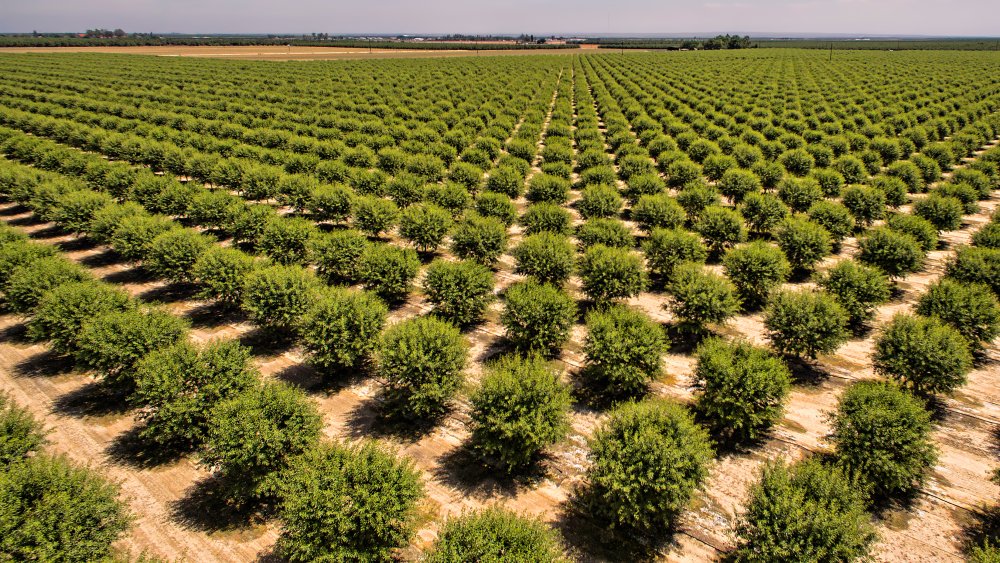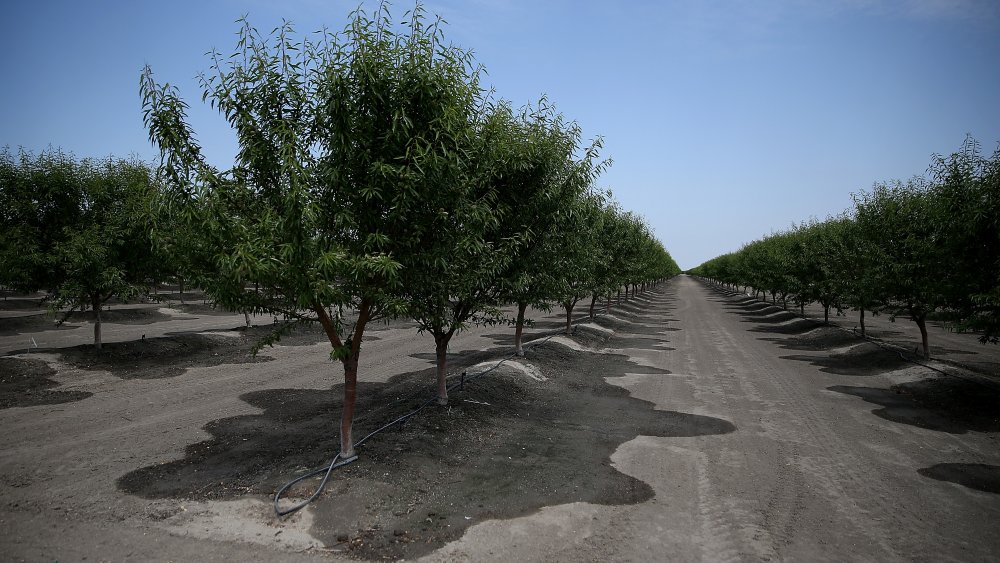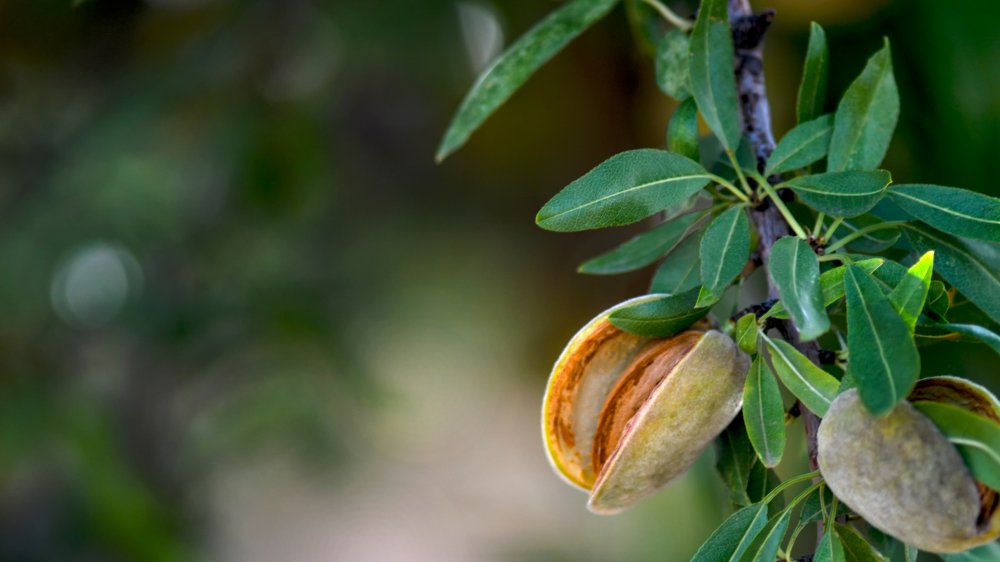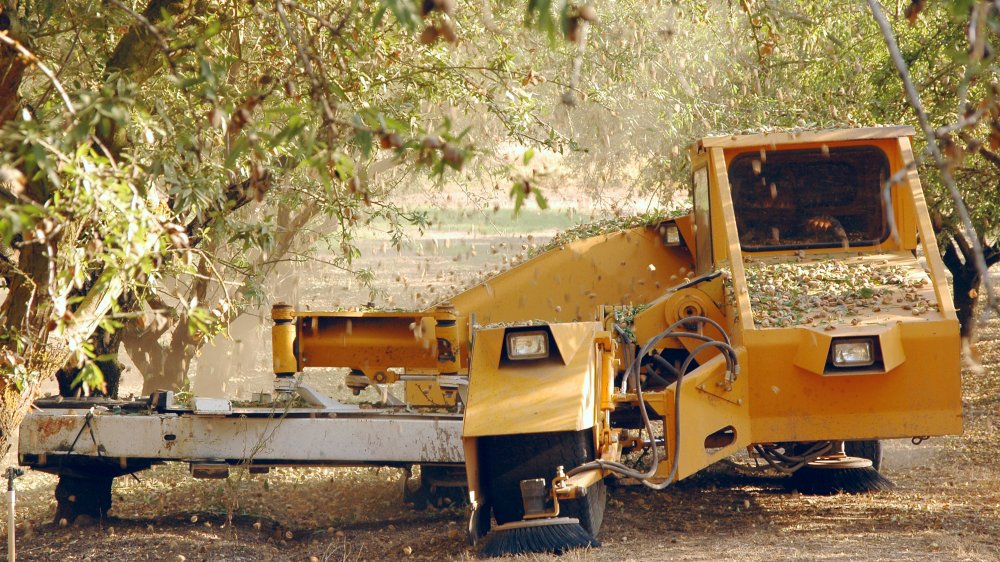The Real Reason Almonds Are Destroying California
You're looking at one of the Californian almond groves that produce 80 percent of the world's almond crops (via The Sacramento Bee). In 2020, the California almond industry predicts it will churn out 3 billion pounds of the nut, 18 percent more than it did in 2019 (via California Almonds). Good news for the industry — catastrophic news for the environment.
The water footprint of a single California almond is 3.2 gallons (equal to 1 million gallons per acre per year), meaning that, per year, almonds guzzle enough H20 to supply all of the households in the Los Angeles, San Diego, and San Francisco Bay areas (via National Geographic, Science Direct, and Grist). And almond producers will do anything to get that water, including outbidding entire cities.
Almond growing and water problems
In fairness, California and the Colorado River basin (which California relies on heavily for water) have struggled with serious water shortages for decades (via ProPublica). This problem is vast and didn't begin with almond growers, who've become a lightning rod. But almond farming is responsible for 10 percent of California's water consumption, more than all of Los Angeles (via NatureHub). So it plays a significant role in water depletion.
Almond producers are also drilling deeper into the soil, using well water that is saltier and, in some cases, laced with naturally-occurring arsenic, the consumption of which has been linked to heart disease and cancer (via Grist). The situation is so dire that the San Joaquin Valley is actually sinking due to water depletion (via the University of Southern California). Lack of water, moreover, is wreaking havoc on California's ecosystem, threatening geese, ducks, and certain native fish populations, and provoking more wildfires (NRDC).
More serious still? Because almond farming doesn't allow for crop rotation, it destroys the soil that it uses, contributing to desertification in California, a state whose economy is dependent on agriculture (via NatureHub and KCET).
Where have all California's bees gone?
As if sucking California dry weren't serious enough, California's almond industry is also killing off bees. Almond growers in California rent around 1.5 million colonies of honeybees a year, without which they couldn't pollinate their trees (via Science Daily). The bees they use are dying at alarming rates, wiping out as much as 12 percent of a beekeepers industry in a matter of months (via Science Daily and The Guardian).
Why? Part of it has to do with the enormous amounts of fungicides and insecticides that almond growers use, in particular, an herbicide called glyphosate which is lethal to bees. Although these substances were deemed "bee-safe," in 2019, Ohio State University researchers reported that these chemicals were lethal to bee larvae. Luckily, that realization caused many almond farmers to reduce their use of insecticides during the almond bloom.
Another factor is that bees thrive in a biodiverse landscape, and almond orchards are just not that. According to The Guardian, these conditions are in part responsible for the fact that more bees die every year than all other animals raised for slaughter in the United States. This is not just an issue for bees-rights activists. It's a food security issue. Per the BBC, bees pollinate the vast majority of the crops that feed 90 percent of us humans. Without them, moreover, California could be looking at losing the myriad of plants and animals that pollination sustains (via Environmental Technology).
The hard truth behind almonds' pesticide dependence and autism
The California almond industry's use of pesticides isn't just dangerous to bees. Research suggests that it is also dangerous to local, human, communities. The same herbicide, glyphosate, that is killing California's bees, for example, as been linked to cancer, and particularly to lymphoma, in humans (via The Guardian).
The problems don't stop there. The Pesticide Action Network has found traces of nine pesticides in almonds, including, chlorpyrifos. Chlorpyrifos, which the Pesticide Action Network found in 35.7 percent of the almonds it studied is so dangerous to brain development that activists groups in California are seeking to ban its use completely (via North State Public Radio). In fact, scientific studies based specifically on people living in California's agricultural region have positively linked prenatal exposure to chlorpyrifos with a higher probability of autism (via the BMJ).
The moral of the story? Think twice before eating almonds.



